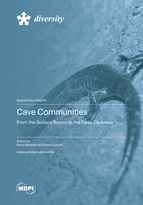Cave Communities: From the Surface Border to the Deep Darkness
A special issue of Diversity (ISSN 1424-2818). This special issue belongs to the section "Biogeography and Macroecology".
Deadline for manuscript submissions: closed (30 November 2020) | Viewed by 36616
Special Issue Editors
Interests: zoology; herpetology; planarians; crayfish; cave biology
Special Issues, Collections and Topics in MDPI journals
Interests: herpetology; cave biology; ecology; evolution; conservation
Special Issues, Collections and Topics in MDPI journals
Special Issue Information
Dear Colleagues,
From a biological perspective, the subterranean realm is one of the less studied but at the same time it is one of the most promising theatre for new findings and researches. Compared to those on the surface, the ecological conditions in subterranean habitats are relatively simple, and this may be an optimal scenario for understanding the mechanisms allowing the colonization, adaptation, and evolution of species, as well as their interactions within local communities. Diversity in subterranean habitats is often overlooked, and few studies embrace whole communities or try to assesses functional relationships between species.
This Special Issue will comprise papers covering a wide range of aspects related to the distribution, composition, and roles of subterranean communities, from bacteria and fungi to invertebrate and vertebrate animals, including papers addressing the effect of intraspecific interactions such as cannibalism among different developmental stages. All typologies of subterranean habitats will be covered, from artificial (tunnels, draining galleries, etc.) to natural (caves, interstices, and lava-tubes), including ecotonal and interfacial habitats (like springs, seepages, and cave entrances). Papers addressing the use of subterranean environments by surface species and how their presence integrates with obligate cave-dwelling species are especially welcome. Papers selected for this Special Issue can also be focused on the conservation of cave communities.
Dr. Raoul Manenti
Dr. Enrico Lunghi
Guest Editors
Manuscript Submission Information
Manuscripts should be submitted online at www.mdpi.com by registering and logging in to this website. Once you are registered, click here to go to the submission form. Manuscripts can be submitted until the deadline. All submissions that pass pre-check are peer-reviewed. Accepted papers will be published continuously in the journal (as soon as accepted) and will be listed together on the special issue website. Research articles, review articles as well as short communications are invited. For planned papers, a title and short abstract (about 100 words) can be sent to the Editorial Office for announcement on this website.
Submitted manuscripts should not have been published previously, nor be under consideration for publication elsewhere (except conference proceedings papers). All manuscripts are thoroughly refereed through a single-blind peer-review process. A guide for authors and other relevant information for submission of manuscripts is available on the Instructions for Authors page. Diversity is an international peer-reviewed open access monthly journal published by MDPI.
Please visit the Instructions for Authors page before submitting a manuscript. The Article Processing Charge (APC) for publication in this open access journal is 2600 CHF (Swiss Francs). Submitted papers should be well formatted and use good English. Authors may use MDPI's English editing service prior to publication or during author revisions.
Keywords
- Cave biology
- Subterranean
- Biodiversity
- Zoology
- Ecology
- Interaction
- Hypogean
- Spring
- Karst







